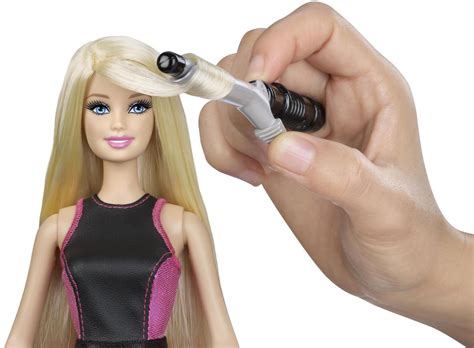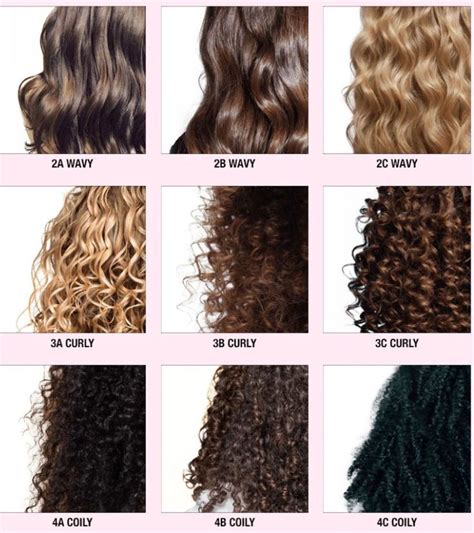Introduction

For those with curly hair, embracing your natural texture is a journey of self-discovery and expression. Understanding the different types of curls can help you find the best care routine, products, and styles to enhance their beauty. This extensive guide will delve into the diverse world of curly hair, empowering you to celebrate your unique hair type.
Andre Walker, a renowned hairstylist, developed the Andre Walker Hair Typing System to classify curly hair into four categories, each with its own unique characteristics.
- Loose, bouncy curls
- Defined S-shaped pattern
- Diameter of a pencil
- Defined, springy curls
- Spiral or corkscrew shape
- Diameter of a Sharpie marker
- Tight, corkscrew curls
- S-shape is less defined
- Diameter of a straw
4A
- Fine, tightly coiled curls
- “Z” or “S” shape
- Often dry and prone to breakage
4B
- Coarse, tightly packed curls
- Less defined shape
- Tends to be dense and shrink-resistant
4C
- Extremely fine, tightly coiled curls
- “S” or “Z” shape but may appear straight
- Very dry and prone to tangles
Identifying your curl type can help guide your hair care and styling choices. Use the following questions to assess your curls:
- What is the diameter of your curls?
- Are they defined or less defined?
- Do they spring back into shape after being stretched?
- How easily do they tangle?
- Are they dry or well-hydrated?
Porosity
In addition to curl type, porosity refers to how well your hair absorbs and retains moisture. High-porosity hair absorbs moisture quickly but loses it just as fast, while low-porosity hair repels moisture and requires deeper conditioning treatments.
- Wash your hair with a sulfate-free shampoo 2-3 times per week.
- Apply a deep conditioner or hair mask weekly to hydrate and repair.
- Avoid over-washing, which can strip your hair of natural oils.
- Use a leave-in conditioner to detangle and add moisture.
- Apply products to wet hair to prevent breakage.
- Consider co-washing, a technique that involves washing with conditioner only.
- Use a wide-tooth comb or detangling brush to avoid breakage.
- Apply anti-frizz products to smooth and define curls.
- Explore different styling techniques, such as the “plopping” method or finger coiling.
- Shampoos: Look for sulfate-free formulas with natural ingredients like shea butter, coconut oil, or argan oil.
- Conditioners: Choose deep conditioners or leave-in conditioners with emollients like aloe vera, glycerin, or ceramides.
- Styling products: Consider anti-frizz creams, gels, or mousses to define and hold curls in place.
- Hydrate your hair regularly with deep conditioners, hot oil treatments, or steam.
- Use products with humectants, such as glycerin or honey, to draw moisture into your hair.
- Strengthen your curls with protein treatments 1-2 times per month.
- Look for products with protein sources like keratin, collagen, or quinoa.
- Protect your hair from heat damage by using a heat protectant spray before styling.
- Cover your hair with a scarf or hat when exposed to the sun or cold weather.
- Avoid over-manipulating your curls to prevent breakage.
- Use microfiber towels to absorb excess moisture without causing friction.
- Invest in a satin pillowcase or bonnets to reduce friction and breakage while you sleep.
- Explore different headbands, scrunchies, and hair ties that are gentle on your curls.
Understanding the different kinds of curly hair empowers you to embrace your unique texture and create a personalized hair care routine. By following these tips and using the right products, you can enhance the beauty and health of your curls, unlocking their natural potential. Remember, the journey to healthy, beautiful curls is a celebration of your individuality, so enjoy the process and let your curls shine!
Table 1: Curl Type Characteristics
| Curl Type | Diameter | Shape | Coarseness | Definition | Shrinkage |
|---|---|---|---|---|---|
| 3A | Pencil | S-shaped | Loose | Defined | Moderate |
| 3B | Sharpie marker | Spiral or corkscrew | Defined | Springy | Significant |
| 3C | Straw | S-shape (less defined) | Tight | Frizz-prone | Significant |
| 4A | Fine | Z or S-shaped | Fine | Dry, prone to breakage | High |
| 4B | Coarse | Less defined | Coarse | Dense, shrink-resistant | Moderate |
| 4C | Extremely fine | S or Z-shaped (may appear straight) | Fine | Dry, prone to tangles | Very high |
Table 2: Products for Different Curl Types
| Curl Type | Shampoo | Conditioner | Styling Products |
|---|---|---|---|
| 3A | Sulfate-free, gentle | Deep conditioner, leave-in conditioner | Anti-frizz creams, gels |
| 3B | Sulfate-free, moisturizing | Emollient-rich conditioner, leave-in conditioner | Gels, curl creams, mousses |
| 3C | Sulfate-free, moisturizing | Deep conditioner, protein treatments | Anti-frizz gels, defining creams |
| 4A | Sulfate-free, protein-rich | Protein treatments, deep conditioner | Curl creams, anti-frizz sprays |
| 4B | Sulfate-free, moisturizing | Deep conditioner, leave-in conditioner | Curl gels, hair butters |
| 4C | Sulfate-free, moisturizing | Deep conditioner, protein treatments | Hair butters, curl pudding, twist creams |
Table 3: Hair Care Tips for Different Curl Types
| Curl Type | Moisture | Protein | Protection | Accessories |
|---|---|---|---|---|
| 3A | Regular hydration | Occasional protein treatments | Heat protectant, satin pillowcase | Soft headbands, scrunchies |
| 3B | Deep hydration | Protein treatments 1-2 times per month | Heat protectant, scarf in cold weather | Wide-tooth combs, satin pillowcase |
| 3C | Intense hydration | Protein treatments 1-2 times per month | Heat protectant, bonnet in cold weather | Detangling brushes, satin pillowcase |
| 4A | Constant hydration | Protein treatments 1-2 times per week | Heat protectant, scarf in cold weather | Microfiber towels, satin pillowcase |
| 4B | Deep hydration, hot oil treatments | Protein treatments 1-2 times per week | Heat protectant, bonnet in cold weather | Satin pillowcase, cotton headbands |
| 4C | Intense hydration, steam treatments | Protein treatments 1-2 times per week | Heat protectant, bonnet in cold weather | Satin pillowcases, bonnets, fabric-covered headbands |
Table 4: Styling Techniques for Different Curl Types
| Curl Type | Styling Techniques |
|---|---|
| 3A | Finger coiling, “plopping” method |
| 3B | Diffusing, finger coiling, flexirods |
| 3C | Denman brushing, “shingling” method |
| 4A | Twisting, braiding, finger coiling |
| 4B | Bantu knots, twist and curl technique |
| 4C | Twisting, braiding, finger coiling |
